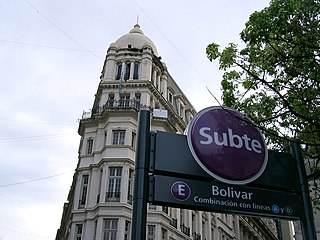
The Buenos Aires Underground, locally known as Subte, is a rapid transit system that serves the area of the city of Buenos Aires, Argentina. The first section of this network opened in 1913, making it the 13th earliest subway network in the world and the first underground railway in Latin America, the Southern Hemisphere, and the Spanish-speaking world, with the Madrid Metro opening nearly six years later, in 1919. As of 2023, Buenos Aires is the only Argentine city with a metro system.

Line B of the Buenos Aires Underground runs 11.75 kilometres (7.30 mi) from Leandro N. Alem to Juan Manuel de Rosas in Villa Urquiza. Line B opened to the public on 17 October 1930.

Line C of the Buenos Aires Underground, that runs from Retiro to Constitución terminus, opened on 9 November 1934, and it has a length of 4.3 km (2.7 mi). It runs under Lima Sur, Bernardo de Irigoyen, Carlos Pellegrini, Esmeralda, la Plaza San Martín and Avenida Ramos Mejia streets. It not only connects to every other line on the system, but its termini at Retiro and Constitución also connect it to some of the most important commuter rail networks in Buenos Aires, such as the Mitre and Roca lines and also long-distance passenger services. It is thus an important artery in Buenos Aires' transport system. At the same time, it is also the shortest line in both terms of length and number of stations.

Line D of the Buenos Aires Underground runs from Catedral to Congreso de Tucumán. The line opened on 3 June 1937 and has been expanded to the north several times. The line is currently 11 km long and has 16 stations, while running approximately parallel to the city's coastline.

Line H is a line of the Buenos Aires Underground. The first phase, between Plaza Once and Caseros, which opened on 18 October 2007, currently stretches over 8.8 km between Hospitales and Facultad de Derecho stations. It is the first entirely new line built in Buenos Aires since the opening of Line E on 20 June 1944.

Line E of the Buenos Aires Underground runs from Retiro to Plaza de los Virreyes, a total distance of 12 km. Opened in 1944, the Line E was the last completely new line to be added to the Buenos Aires Underground, until 2007 when Line H was opened. The line has a history of being re-routed and extended due to having been historically the line with the lowest passenger numbers on the network.
Line G is a planned addition to the Buenos Aires Underground which has been on the drawing board in numerous forms since the 1930s. After a failed attempt at financing and building the line in 2009, its most recent proposal was put forward in 2015 by the government of Buenos Aires.

Line I is a planned addition to the Buenos Aires Underground.

Federico Lacroze railway station is a passenger railway station in Buenos Aires, Argentina. The station is located in the city's outlying barrio (neighbourhood) of Chacarita in a predominantly residential area. It is just a short distance north of the Cementerio de la Chacarita, the city's largest cemetery. The station is named after Federico Lacroze, a prominent 19th century Argentine railway and transport pioneer who obtained the concession for building the Buenos Aires Central Railway in 1884. When the Argentine railway network was nationalised in 1948 the station became the Buenos Aires terminus for the lines that became part of the General Urquiza Railway (FCGU).

The Premetro is a 7.4-kilometer long (4.6 mi) light rail line that runs along the outskirts of Buenos Aires, connecting with the Buenos Aires Underground line E, at Plaza de los Virreyes station and then to General Savio, with a short branch to Centro Cívico. It opened in 1987 and is operated by Metrovías. Originally, the Premetro was to include many more lines, but shortly after the privatisation of the railways the projects were postponed and never materialised and only "Premetro E2" was built.

Railway privatisation in Argentina was a process which began in 1989 under the presidency of Carlos Menem, following a series of neoliberal economic reforms. This primarily consisted of breaking up the state-owned railway company Ferrocarriles Argentinos (FA) and allowing the former lines to be operated by private companies instead of the state.

The Buenos Aires Metrobús is a 50.5 km (31.4 mi) network of dedicated separated lanes and stations for buses that serve the city of Buenos Aires, Argentina. Designed as a Bus Rapid Transit system, it mixes a few bi-articulated buses with conventional buses. The headway is the same as before the implementation of the system, and the buses on the system use the same brand as the main network, that is, maintaining their previous branding as common bus lines with their own numbers. The service operates 24 hours a day and 365 days a year, with 2-4 minute frequencies during the day and 10–15 minutes at night.

Constitución is a ghost station in the Buenos Aires Underground, which was part of Line E until its closure in 1966. It is one of two ghost stations on the line, the other being San José vieja. This was the original terminus of the line when it ended at Constitución railway station and combined with Line C there.
San José vieja is a ghost station in the Buenos Aires Underground, which was part of Line E until its closure in 1966. It is one of two ghost stations on the line, the other being Constitución.

The Regional Express Network was a planned commuter network system in Buenos Aires, which consisted in an underground connection among the 3 mainline railway stations of the city: Retiro, Constitucion and Once, in the north, south and west respectively.

The CSR EMU is a series of electric multiple unit cars manufactured by CSR Corporation Limited for use on Buenos Aires' commuter rail network. As of 2015, the trains operated on three of the city's lines and 705 cars were manufactured, with each line using a different number of cars per train. They were created for use on lines electrified using both third rail and overhead lines.

The Siemens-Schuckert Orenstein & Koppel is an underground car formerly used on the Buenos Aires Underground first built by Siemens-Schuckert and Orenstein & Koppel in 1934, 1937 and 1944 with a smaller number of cars built in Argentina during the 1950s. The Siemens O&K rolling stock made up the entirety of the trains used on the three lines built by the Hispanic-Argentine Company for Public Works and Finances (CHADOPyF) and has since served on every line of the Underground from 1934 to 2016, with cars refurbished by the Emepa Group and Alstom continued to function on the network till 2017.
The Buenos Aires Underground has one of the most diverse metro fleets in the world, and has had some of the oldest models in operation on any network. The network began with a relatively standardised fleet, but throughout its over 100-year-long history, it has seen numerous purchases which have created cases where some lines operate numerous models. Recently there have been increased efforts to modernise and standardise the fleets, with large purchases from China CNR Corporation and Alstom.

The 100 Series are a series of underground railway cars manufactured by Alstom in Brazil and Argentina for use on the Buenos Aires Underground. They are used on Line D of the network, where they make up the vast majority of the fleet, serving alongside some 300 Series and Fiat-Materfer cars. Since 2019, some units have also been used on the Line E.

The 300 Series are a set of underground cars manufactured by Alstom in Brazil for use on the Buenos Aires Underground. They are used on Line H of the network, and more have been introduced on Line D where they operate alongside the similar 100 Series.


















